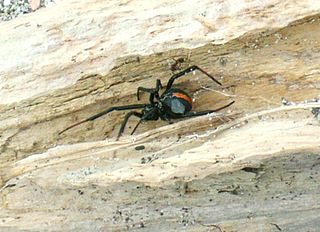
The Pholcidae are a family of araneomorph spiders. The family contains over 1,800 pholcids, including those commonly known as the marbled cellar spider , daddy long-legs spider, granddaddy long-legs spider, carpenter spider, daddy long-legger, vibrating spider, gyrating spider, long daddy, and skull spider. The family, first described by Carl Ludwig Koch in 1850, is divided into 94 genera.

Johann Kaspar Füssli, also written Johann Caspar Fuesslins or Fuessly, was a Swiss painter, entomologist and publisher.

The spider genus Pholcus contains the cellar spider P. phalangioides, often called the "daddy longlegs". There are 321 accepted species in the genus according to May 2016 in World Spider Catalog.

The Rarotonga monarch, also known as the Rarotonga flycatcher or kakerori, is a species of bird in the monarch flycatcher family Monarchidae. It is endemic to the Cook Islands.

Pholcus phalangioides, commonly known as daddy long-legs spider or long-bodied cellar spider, is a spider of the family Pholcidae. It is also known as the skull spider due its cephalothorax resembling a human skull. This is the only spider species described by the Swiss entomologist Johann Kaspar Füssli, who first recorded it in 1775. Its common name of "daddy long-legs" should not be confused with a different arachnid species with the same common name, the harvestman (Opiliones).
Stenolemus bituberus is a species of thread-legged insect (Emesinae) found across much of Australia. This species spends nearly its entire life in spider webs. It preys upon a variety of spiders, including webs and nests of spiders of Achaearanea, Badumna, Pholcus, and Stiphidion, and the families Salticidae and Uloboridae. This species is found in a broader diversity of spider webs than any other species in Stenolemus.

New Zealand has 1134 described spider species, with an estimated total fauna of 2000 species. Over 90 per cent are endemic, and the rest have been introduced through human activities or were natural wind-borne introductions.

Australia has a number of highly venomous spiders, including the Sydney Funnel-web, its relatives in the family Hexathelidae, and the Redback Spider, whose bites can be extremely painful and have historically been linked with deaths in medical records. Most Australian spiders do not have venom that is considered to be dangerously toxic. No deaths caused by spider bites in Australia have been substantiated by a coronial inquest since 1979. There are sensationalised news reports regarding Australian spiders that fail to cite evidence. A Field Guide to Spiders of Australia published by CSIRO Publishing in 2017 featuring around 836 species illustrated with photographs of live animals, around 381 genera and 78 families, introduced significant updates to taxonomy from Ramirez, Wheeler and Dmitrov

Pholcus opilionoides is a species of spider in the family Pholcidae found in Europe, Egypt, the Caucasus and possibly Iran.
Pholcus ponticus is a cellar spider species found from Bulgaria to China.
Pholcus velitchkovskyi is a cellar spider species found in Russia, Ukraine and Iran.
Sihala ceylonicus, is a species of spider of the genus Sihala. It is known to be endemic to Sri Lanka, some suggest its presence in Malaysia as well.
Sihala is a genus of cellar spiders in the family Pholcidae, containing two species. The two species were once classified in the genus Pholcus, but were moved due to the absence of the characteristic sclerites shown in the bulb, and the unusually small and simple procursus.
Pholcus fragillimus, is a species of spider of the genus Pholcus. It is distributed from Sri Lanka, India to Japan. The type material of Pholcus fragillimus has probably been destroyed in Stuttgart during the Second World War, and only one female is available now in museums.
Cantikus v-notatus is a species of spider in the family Pholcidae. It is found from Myanmar to Indonesia.
Tissahamia ethagala is a species of spider in the family Pholcidae. It is endemic to Sri Lanka.
Tissahamia maturata is a species of spider in the family Pholcidae. It is endemic to Sri Lanka.
Wanniyala is a genus of cellar spiders native to Sri Lanka, first described by Huber & Benjamin in 2005. They have six eyes and four pair of legs and grow up to 2 mm in length. The abdomen is globular and males have a distinctive distal hinged sclerite on the procursus of genitalia. The name is derived from the Sri Lankans native to the island that the first spiders were found on- the Vedda people- and their surname Wanniyala-Aetto.

Pholcus manueli, known generally as the cellar spider or daddy longlegs, is a species of cellar spider in the family Pholcidae. It is found in Russia, Turkmenistan, China, Korea, Japan, and the United States.







